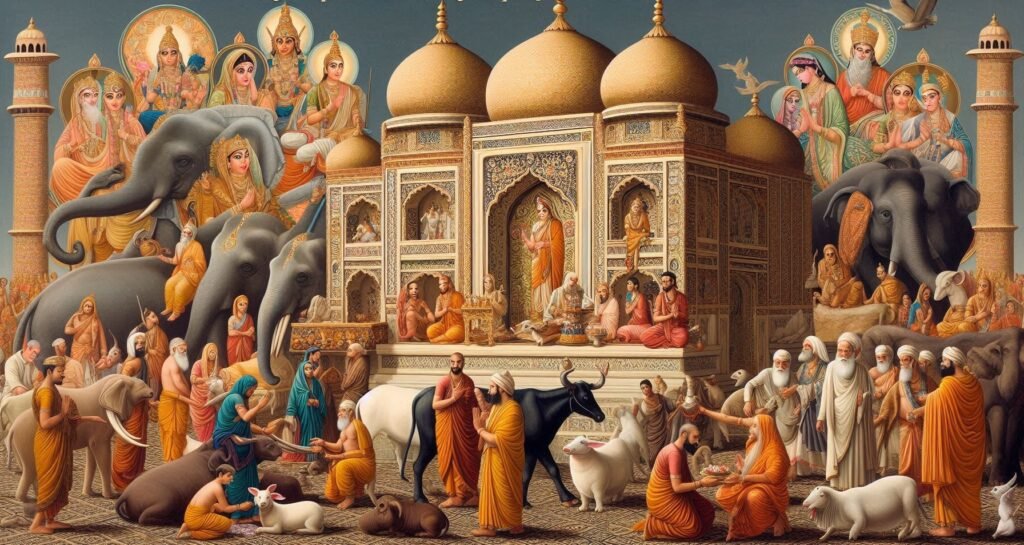
Introduction
India is a country of diverse religious and cultural traditions that shape not only social norms but also people’s treatment of animals. The nation is home to several religions, including Hinduism, Islam, Christianity, Buddhism, and Jainism, each of which holds distinctive beliefs and practices regarding the relationship between humans and animals. These religions, coupled with India’s rich cultural history, have played an instrumental role in shaping the country’s approach to animal welfare. While modern legal frameworks exist to protect animals, the influence of religion and culture on these practices cannot be understated. This article explores how religion and culture in India contribute to shaping attitudes and practices toward animal welfare, demonstrating the deep connection between belief systems and the humane treatment of animals.
Historical Context of Animal Welfare in India
India’s ancient texts and spiritual practices have long emphasized the sacredness of life, including the lives of animals. Ancient Hindu scriptures such as the Vedas and Upanishads contain references to non-violence and compassion toward all living beings. The principle of Ahimsa—meaning non-harming or non-violence—is central to Hinduism, Jainism, and Buddhism. This principle has shaped societal values concerning the treatment of animals, emphasizing their right to live free from harm.
For example, Manusmriti, an ancient legal text, states: “He who injures harmless beings from a wish to give himself pleasure, never finds happiness, whether living or dead” (Manusmriti 5.45). This passage reflects the deeply ingrained belief in the sanctity of all forms of life. The influence of such texts is evident in the cultural practices that emphasize kindness and protection of animals, which have been incorporated into India’s legal and social frameworks for centuries (Kumar, 2020).
Hinduism and Animal Welfare
Hinduism, the most widely practiced religion in India, has greatly influenced animal welfare practices. One of the most notable aspects of Hindu animal ethics is the reverence for cows. Cows are considered sacred, representing motherhood, fertility, and non-violence. The cow’s
status in Hinduism has resulted in numerous cultural and religious practices that protect these animals. As a result, many Indian states have implemented laws prohibiting cow slaughter, reflecting the religious sentiment of cow protection (Gau Raksha) (Chapple, 2021).
Other animals also hold significant religious importance. Elephants, for instance, are revered in Hinduism, symbolized by the deity Ganesha, who is depicted with the head of an elephant. Elephants are treated with respect and are central to religious festivals and rituals. However, this has also led to debates regarding the use of elephants in temple rituals and festivals, where animal rights activists have raised concerns over cruelty and exploitation (Natrajan & Jacob, 2018).
Hindu festivals often include animals in their religious rituals. For example, during Nag Panchami, a festival dedicated to the worship of snakes, devotees offer milk and flowers to live snakes, symbolizing respect and reverence for these creatures. This cultural practice stems from the belief that all forms of life are interconnected and must be treated with compassion.
Jainism: The Pinnacle of Ahimsa
Jainism, an ancient Indian religion, is often considered the most rigorous in its commitment to non-violence. Ahimsa is the core ethical tenet of Jainism, and this extends to all living beings, from the smallest insects to large mammals. Jains believe that any form of harm to animals or other living beings incurs negative karmic consequences. Consequently, Jains are strict vegetarians, refraining from eating meat, eggs, and even root vegetables to avoid harming small organisms in the soil (Laidlaw, 2017).
Monks and nuns within the Jain tradition take extraordinary measures to avoid harming even the smallest creatures. They wear cloths over their mouths to prevent accidentally inhaling insects and sweep the ground in front of them to avoid stepping on tiny organisms. The Jain community has historically contributed to various animal welfare movements in India, supporting laws and initiatives that aim to reduce animal suffering and cruelty. Their commitment to Ahimsa has helped inspire broader societal attitudes of compassion and care for animals (Chapple, 2021).

Buddhism and Compassion for All Sentient Beings
Buddhism, which originated in India, also promotes compassion and respect for all sentient beings. Karuna (compassion) and Metta (loving-kindness) are central to Buddhist ethics and are applied to animals as well as humans. Buddha taught that all living beings are subject to
suffering, and it is the moral duty of individuals to minimize the suffering of others, including animals (Harvey, 2000).
In regions of India where Buddhism is still widely practiced, such as Ladakh and Sikkim, this religious philosophy has influenced local animal welfare practices. For instance, Buddhists in these areas refrain from hunting, fishing, and consuming animal products, promoting vegetarianism as a means of reducing harm to animals. Buddhist monasteries often take an active role in protecting local wildlife, reflecting the religion’s broader emphasis on preserving the natural environment (Harvey, 2000).
Islam’s Ethical Treatment of Animals
Islam is practiced by a significant portion of India’s population, and its teachings also emphasize the humane treatment of animals. The Quran and Hadiths provide guidelines for how animals should be treated. Islam permits the consumption of meat but requires that animals be treated ethically and slaughtered in a manner that minimizes suffering, known as halal slaughter. The Prophet Muhammad is often quoted as saying, “Whoever is kind to the creatures of God is kind to himself” (Sahih Bukhari 6001).
In Islam, animals are seen as part of God’s creation, and humans are considered stewards who must care for them. Acts of cruelty towards animals are strongly condemned. For instance, in a famous Hadith, a woman was said to be punished in the afterlife for mistreating a cat, while another person was rewarded for giving water to a thirsty dog. These teachings have helped cultivate an ethos of compassion toward animals in Islamic communities in India (Siddiqui, 2022).
Cultural Practices and Their Impact on Animal Welfare
Cultural traditions in India are equally influential in shaping how animals are treated. In rural communities, animals such as cows, buffaloes, goats, and camels are often viewed as valuable assets, providing milk, labor, and transportation. These animals are treated with care and respect due to their crucial role in the survival of agricultural households. For example, in Rajasthan, camels are revered, particularly during the Pushkar Camel Fair, where they are decorated, paraded, and traded (Kumar, 2020).
However, some cultural practices involving animals have come under scrutiny for their ethical implications. Jallikattu, a traditional bull-taming sport in Tamil Nadu, has sparked significant debate over animal rights. While proponents argue that it is a centuries-old cultural practice that must be preserved, animal welfare activists contend that the sport subjects bulls to unnecessary cruelty and stress (Ghosh, 2019).
Legal Framework for Animal Welfare in India
India has established several laws aimed at protecting animals, many of which reflect the country’s religious and cultural values. The Prevention of Cruelty to Animals Act, 1960, is a landmark piece of legislation that prohibits the infliction of unnecessary pain or suffering on animals and mandates the humane treatment of animals. The act also led to the creation of the Animal Welfare Board of India (AWBI), which oversees animal welfare initiatives and enforces animal protection laws (AWBI, 2023).
The Wildlife Protection Act of 1972 is another crucial law that seeks to protect India’s wildlife from poaching and habitat destruction. Several species that are considered sacred or culturally significant, such as tigers, elephants, and peacocks, are protected under this act. These laws demonstrate the fusion of legal frameworks with the cultural and religious ethos that emphasizes respect for life (Singh, 2018).
Challenges to Animal Welfare in India
Despite the strong influence of religion and culture in promoting animal welfare, several challenges persist. Rapid urbanization, industrialization, and the growing demand for animal products have put immense pressure on animals, both domestic and wild. Stray animals, particularly dogs and cattle, are common in India’s cities and towns, often facing neglect, starvation, and cruelty (Deka, 2020).
Illegal wildlife trafficking, poaching, and habitat destruction continue to threaten India’s biodiversity. Religious festivals and cultural practices, while rooted in respect for animals, sometimes result in cruelty or exploitation. For example, during certain festivals, animals are subjected to overcrowded and unsanitary conditions, which raise ethical concerns about their treatment.

Balancing Tradition with Modern Animal Welfare Principles
There is a growing need to reconcile traditional practices with modern understanding of animal rights. While religion and culture have historically promoted the compassionate treatment of animals, global movements for animal welfare, informed by scientific knowledge, advocate for even more stringent protections. Educational campaigns, public awareness, and stricter
enforcement of animal welfare laws are necessary to address the complexities of animal welfare in contemporary India.
Additionally, religious and cultural leaders have the potential to drive meaningful change. By emphasizing the ethical treatment of animals within the context of religious and cultural traditions, these leaders can promote a more humane approach to animal welfare that is both respectful of tradition and aligned with modern principles of animal rights.
Conclusion
Religion and culture have had a profound impact on the treatment of animals in India, shaping attitudes and practices that emphasize compassion, non-violence, and respect for all living beings. While Hinduism, Jainism, Buddhism, Islam, and other religious traditions have promoted the humane treatment of animals, challenges remain in balancing cultural practices with modern animal welfare standards. India’s legal framework provides robust protections for animals, but continued efforts are needed to address the evolving challenges facing animal welfare in the country. By drawing on the strengths of religious and cultural values, India can continue to make progress toward a more ethical and compassionate treatment of animals.
Refrences
- Chapple, C. K. (2021). Nonviolence to animals, earth, and self in Asian traditions. State University of New York Press
- Deka, K. (2020). India’s growing stray animal crisis. India Today
- Ghosh, S. (2019). Debate over Jallikattu: Culture vs. animal rights. Indian Journal of Ethics in Medicine, 5(2), 45-58
- Harvey, P. (2000). An introduction to Buddhist ethics: Foundations, values, and issues. Cambridge University Press
- Kumar, N. (2020). Cultural traditions and animal welfare in rural India. Journal of Indian Studies, 12(1), 23-34
- Laidlaw, J. (2017). The Jains: Philosophy, society, and art. Cambridge University Press
- Manusmriti, Verse 5.45
- Natrajan, B., & Jacob, B. (2018). Elephants in Indian religious practices. South Asian Journal of Animal Studies, 9(1), 30-41
- Prevention of Cruelty to Animals Act, 1960, Government of India
- Sahih Bukhari, Hadith 6001
- Siddiqui, M. (2022). Islam and animal welfare: Perspectives from India. Journal of Islamic Ethics, 4(3), 89-102
- Singh, R. (2018). Wildlife conservation in India: Legal framework and issues. National Law University Press
- Wildlife Protection Act, 1972, Government of India




